Create Knockout Homemade Mayonnaise by First Infusing Your Oil with Flavor
Getting flavor into a dish is usually pretty simple. You take whatever ingredient has the flavor you want and mix it in with the dish’s other ingredients. That might require chopping or stirring or blending or mixing or some other prep for the flavorful ingredient, but once it’s been processed enough to incorporate it into the other ingredients, you can be pretty confident its flavor isn’t going anywhere.
Infused oil doesn’t work that way. The idea is instead to take a flavorful ingredient, separate the flavor from all the solid material that makes up the ingredient (the fibers, water, cell material, etc.), and keep only the flavor in the infused oil. Everything else from the original ingredient gets discarded.
Because oil is a solvent, oil infusion works with anything that has flavors soluble in oil. That’s not true for a lot of what we cook with, including most fresh herbs and quite a bit of our perishable produce. The flavors in those things are predominantly water-soluble.
The most reliable oil-soluble flavors come from spices. There are plenty of other sources of oil soluble flavors: Bacon, for example. The rendered fat from bacon is (once diluted with enough vegetable oil to remain liquid) an infused oil. But for nearly can’t-miss oil infusions, spices are the best candidates.
The method is basically the same for any spice. First, start with whole spices: That usually means the whole seed pod, but sometimes (as with cinnamon or licorice) the spice is from a different dried chunk of the plant. The advantage of whole spices is that their flavor remains locked inside. Once a spice is ground to a powder it begins losing its potency in days. After six months or a year, most of its flavor is long gone.
The other advantage to whole spices is that with just a few moments of pan roasting they become supercharged with their own flavor. That’s why the process of making any spice powder, whether intended to flavor an oil or for direct addition to a dish, begins with dry roasting the whole spices. Just put a dry pan over medium heat, add the spices, and swirl the pan or stir the spices several times over the course of 3-4 minutes. The heat of the pan roasts enough of the spices that they become fragrant. Moving them around in the pan occasionally while they roast puts different points of each seed or pod in contact with the pan, toasting more of it and making it less likely any of it will burn. Once the spices are fragrant (and definitely before they give off any burnt aroma), transfer them to a grinder and grind to a powder. Then (as described in more detail below) add that powder to some oil, heat it for long enough to extract its flavor, and filter out all the solids. The infused oil remains.
The sauce for today’s dish is mayonnaise made from oil infused with a 5-spice powder. Any traditional 5-spice powder uses the same spices: Star anise, cinnamon, fennel seed, Sichuan peppercorns, and cloves. There’s no tradition for how much of each to use. It’s quite literally up to you. I like the distinctive flavor of star anise, so I use a little more of it than any of the other spices.
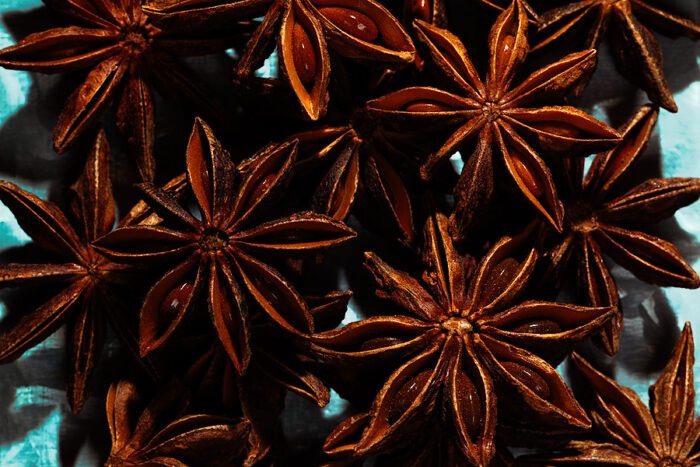
The traditional variety of cinnamon to use is Cassia cinnamon, harvested from the bark of a Cassia tree. Ceylon cinnamon, which is often called “true cinnamon” because it comes from the Cinnamomum verum tree, tastes a little different, though Cassia bark is every bit as much a genuine cinnamon as its Ceylon cousins. They can substitute one-to-one in virtually all recipes, including in 5-spice powder.

The third traditional spice (fennel seed) can be replaced with anise seed, and you likely won’t notice the difference. Use whichever you can get. Sichuan peppercorns and cloves don’t really have any good substitutes.
My 5-spice blend uses 3 parts star anise, 2 parts fennel seeds, 2 parts cinnamon, 1 part Sichuan peppercorns, and 1 part cloves, all by weight. You can try grinding a blend to that proportion, taste it, and if you want more of any constituent’s flavor, grind some of just that spice and stir it in, then note the addition and you’ve got your own custom blend. Just be sure to dry-roast them all first.
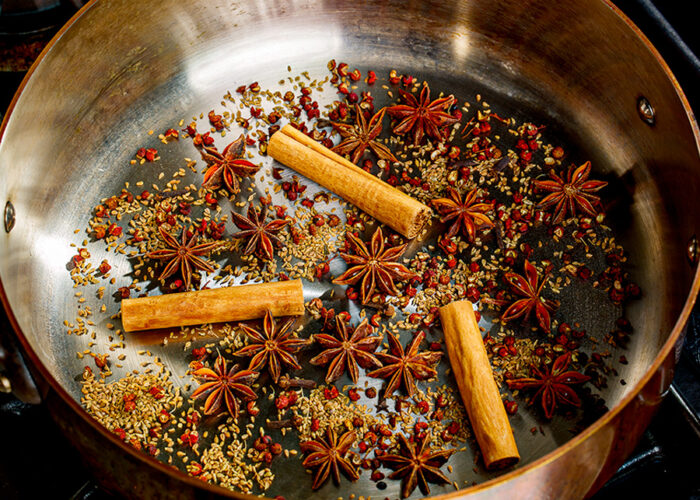
No matter how great your spice grinder is, if you want extra ground spice for use in other recipes, sift it through a medium-mesh strainer. Seed pods are fibrous, and spice grinders can’t chop them down to talcum-powder size. That doesn’t matter when using ground spices to infuse oil since all the solids will be thrown away, but if you want a spice blend to throw into a stir fry or sprinkle on a protein or add directly to a sauce, sift out the big stuff so you won’t taste any tiny spice bits in the final dish.
With the spices groasted (defined as ‘ground and roasted’ in the Jabberwocky lexicon), extracting their flavor into oil just requires heat. The oil should be held anywhere between 150°-200° F for 1-2 hours. Any lower and the extraction might take forever; any higher and the oil is in danger of reaching temperatures that will burn the spices. The higher the temperature the faster the extraction, but as long as the oil stays anywhere in that range, the results will be quite similar.
The easiest way to keep the oil in that range the entire time is to put it in a heatproof bowl along with the spice blend, cover it with plastic wrap, and float it in a sous vide water bath. You can set the bath for whatever temperature you want and the oil will stay within a degree or two of that the entire time. There’s no need to check it or stir the spices.
You could instead put the oil and spice mix in the top of a double boiler and check the temperature every once in a while. The trickiest method is keeping the oil in a saucepan directly on a burner. That requires frequent temperature checks to keep the spices from burning.
Once the infusion is done, put a strainer over a bowl, line it with a coffee filter, and pour the oil in. Then put the whole thing in the refrigerator to filter for at least several hours, which is how long it likely will take. You can speed that up somewhat by straining the oil first through a medium-mesh strainer to get rid of most of the solids, but a coffee filter is still needed to separate out all the fines, and it takes quite a while for all the oil to seep through those fines to the bowl below.
Infused oils, home made mayonnaise, and food safety
As long as you don’t start out with tainted oil or some other contaminated ingredient, infused oils are perfectly safe for a while. But they shouldn’t be left at room temperature for longer than five or six hours, and even in the refrigerator they shouldn’t be kept longer than a week. Infused oils can be stored in the freezer indefinitely, but that’s the only place they remain safe for the long haul.
The eventual risk posed by flavored oils is botulism. Clostridium botulinum bacteria are the spores that produce botulism, and in the world of food they’re almost everywhere. Fortunately, Clostridium botulinum is harmless almost all the time. It doesn’t produce any botulism toxins unless it finds itself in an environment with exactly the right combination of conditions. There can’t be oxygen present (which all by itself is why botulism isn’t a risk for the vast majority of food preparations). The food environment can’t be acidic. It can’t be colder than 38° F, and it can’t be warmer than 122° F. (The reason to strain infused oil in the refrigerator isn’t to get it below 38° — most refrigerators chill to only about 40° F — but rather to get close enough to 38° that any bacterial activity will be glacially slow.)
Once Clostridium botulinum finds itself someplace that meets all those criteria, the bacteria can eventually generate enough toxin to cause botulism. Statistically, the chance of botulism poisoning is passingly small. In any given year there are only about two dozen botulism cases from food poisoning in the entire United States. But in the rare cases when it happens, it’s potentially fatal. There’s no reason to take even a 1-in-a-million risk of that. So use your infused oil right away, or store it in the refrigerator for up to a week, or keep it in the freezer indefinitely.
Those same guidelines apply to the safe life of homemade mayonnaise, except that mayonnaise doesn’t freeze well so that’s not an option for long term storage.
Making mayonnaise with infused oil
Infused oil and regular oil work the same when making mayonnaise. The oil should be somewhere near room temperature. Chilled oil is viscous enough that it doesn’t easily break into tiny droplets to emulsify. When hot, it breaks into droplets but they coalesce again right away, defeating any emulsion. So long as the oil is anywhere between 60° and 80° the oil should work fine. Just follow the basic mayonnaise recipe explained here.
The pleasure from mayonnaise made with an infused oil isn’t just that it’s homemade, nor even that it’s delicious in a way that can’t be bought in a store. It’s that the taste is a surprise. Looking at it on a plate, it looks like store-bought mayonnaise. But it tastes like a luscious sauce flavored with whatever you’ve infused it with.
Today I’ve paired the 5-spice mayonnaise with duck breast, leeks, and diced blood oranges, garnished with red-veined sorrel, orange fluid gel, orange powder, and rose geranium pedals.
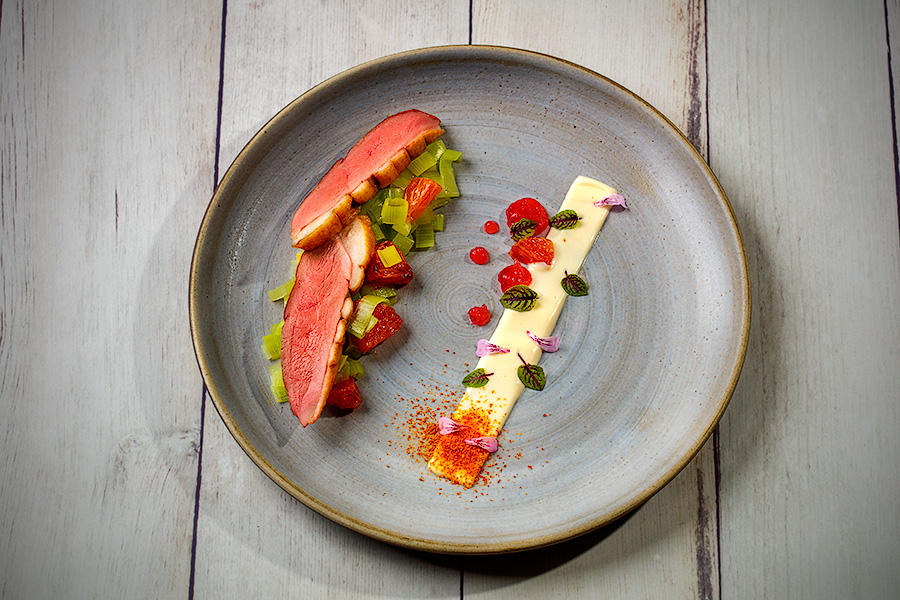
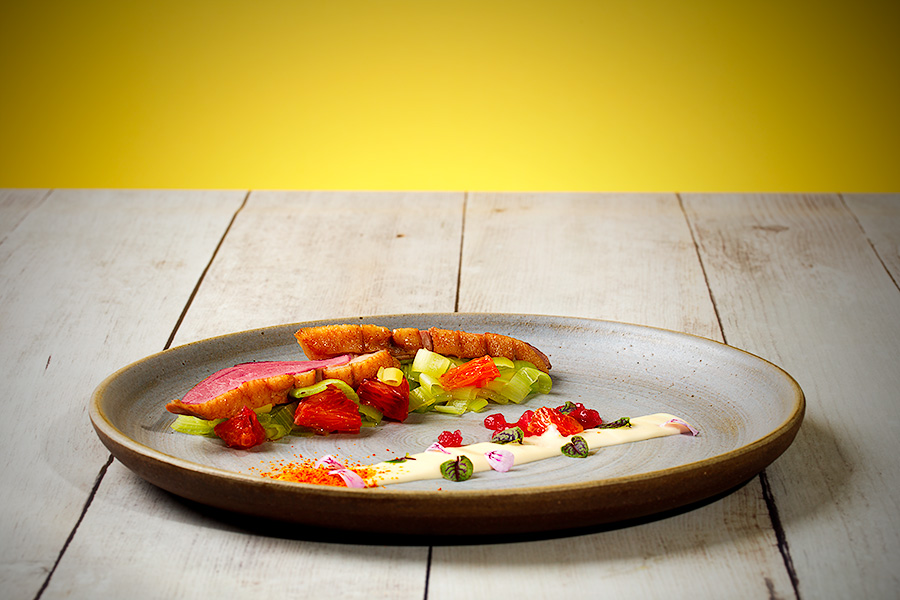
5-Spice Infused Oil Recipe
Makes 1 cup
3 parts Star Anise (9 g = 9 whole pods)
2 parts fennel seeds or anise seeds (6 g = 1 T of them)
2 parts cinnamon stick (6 g = 1 1/2 medium 4-inch sticks)
1 part Sichuan peppers (3 g = 2 1/2 t)
1 part cloves (3g = something like 2 t of them)
1 1/2 c (360 g) neutral oil
Pan roast the whole spices until fragrant. Grind them in a spice grinder. Put the oil in a heatproof bowl, stir about a tablespoon of the 5-spice powder, then bring the oil to a steady temperature between 150° – 200° F for 1-2 hours. Strain the oil through a medium strainer to remove most of the solids. Then line the strainer with a coffee filter, put it on a bowl, pour the oil into the filter and let it drain in the refrigerator for several hours until oil stops draining through. Bring the infused oil to room temperature when ready to use it to make the mayonnaise. If not using the oil at once, keep it chilled in the refrigerator for up to a week, or in the freezer indefinitely.
5-Spice Mayonnaise Recipe
Makes 1 1/4 cups
1 T (15 g) lemon juice or 2 t (10 g) white vinegar
1 egg (50 g)
2 t (10 g) Dijon mustard
1-2 T (15-30 g) water
0.4 g xanthan (optional)
1/8 t (0.8 g) salt
1 c (240 g) 5-spice infused oil
In the bowl of a stand blender put the lemon juice (or white vinegar), the egg, and the mustard. If they don’t come up far enough in the bowl to reach the blender blades, add enough water (typically just a tablespoon or two) until they do.
Combine the salt and xanthan (if using it) together. (Stirring the salt into the xanthan ahead of incorporating them both into a liquid is an easy way to protect against the xanthan clumping.) With the blender running at low speed, sprinkle the salt/xanthan mixture into the liquid.
Turn the blender up to medium speed. Starting very slowly (about a teaspoon of oil at a time) add the infused oil and let the blender process it into the water-based ingredients, which it will do almost instantly. Continue adding oil slowly at first, then after a few seconds add it more rapidly. The entire addition should take at least 10 seconds, but doesn’t need to be drawn out much beyond that so long as the initial oil is added in small quantities.
If the mayonnaise becomes thicker than you want it before all the oil is incorporated, add a teaspoonful of water, which will loosen the mixture.

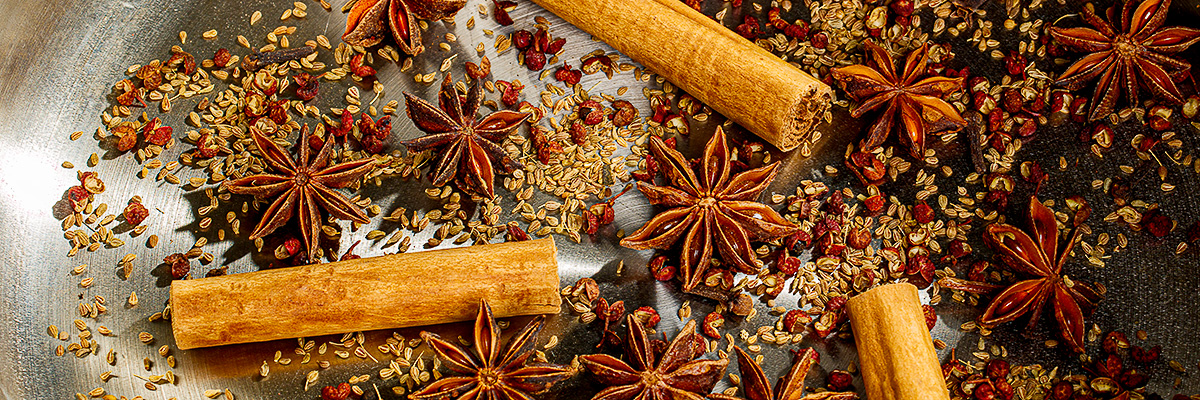
Like this Recipe? Leave a Comment.
Your email address will not be published.